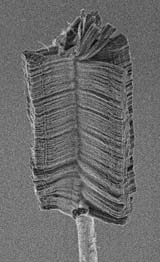Here’s a family of Nanobrushes for Your Tiny Tidy-Ups
 Nano devices and nano components of larger ones cry out for nano tools to tend them. Researchers at Rensselaer Polytechnic Institute led by Pulickel Ajavan have responded by fabricating a family of nanobrushes with silicon carbide fiber handles and millions of carbon nanotube bristles, each ~30 nm in dia. Using a gas-phase delivery technique, the team grew the nanotubes onto the handles by placing those stems into a furnace of vaporized hydrocarbons. To control the shape of the brushes, they wrapped the handles in gold except for the bristle attachment points. One model is shown in the photo; others resemble toothbrushes, brooms, and paintbrushes.
Nano devices and nano components of larger ones cry out for nano tools to tend them. Researchers at Rensselaer Polytechnic Institute led by Pulickel Ajavan have responded by fabricating a family of nanobrushes with silicon carbide fiber handles and millions of carbon nanotube bristles, each ~30 nm in dia. Using a gas-phase delivery technique, the team grew the nanotubes onto the handles by placing those stems into a furnace of vaporized hydrocarbons. To control the shape of the brushes, they wrapped the handles in gold except for the bristle attachment points. One model is shown in the photo; others resemble toothbrushes, brooms, and paintbrushes.
The brushes have been tested both manually and attached to rotating electric motors. Among their likely applications are cleaning microscopic-scale surface features, serving as electrical contacts, and improving certain medical procedures.
Conventional tiny brushes for the electronics industry are made of animal hairs, synthetic polymer fibers, and metal wires. But metals corrode, hair lacks the requisite strength, and synthetic fibers degrade easily.
Thus far, the researchers have used the brushes to remove nanoparticles in microscopic grooves on various substrates, and to clean and coat the inside of a 300-micron-wide capillary tube. Because carbon nanotubes readily conduct electricity, the brushes have been successfully demonstrated as electromechanical switches in micromotors and as electrical contacts. They could also whisk away those annoying nano particulates that encourage static electricity in delicate electronic devices. In the biomedical scene, they could ream out blood vessels. Dipped in absorbent materials, they could soak up silver ion contaminants in water supplies.
The research, conducted in collaboration with the University of Hawaii at Manoa, was funded in part through Rensselaer’s National Science Foundation–Nanoscale Science and Enginering Center for Directed Assembly of Nanostructures, and the Interconnect Focus Center.
Contact Dr. Anyuan Cao, Department of Mechanical Engineering, University of Hawaii at Manoa, Honolulu, HI; 808-956-2142, [email protected].
Keep Foul-ups away from the Fowl Line
 Say you’re digging into a nice microwaved turkey tetrazzini dinner and behold: Your fork raises something that shouldn’t be in there. Ick! It’s probably not metal; commercial food processors use metal detectors to find and eliminate those fragments. So it’s most likely either plastic or, worse, glass.
Say you’re digging into a nice microwaved turkey tetrazzini dinner and behold: Your fork raises something that shouldn’t be in there. Ick! It’s probably not metal; commercial food processors use metal detectors to find and eliminate those fragments. So it’s most likely either plastic or, worse, glass.
At the Georgia Tech Research Institute, John Stewart and colleagues including Doug Britton, Craig Wyvill, and Wayne Daley have been developing a machine vision system that uses sophisticated color discrimination algorithms to identify plastics and other unwelcome items in food products.
The system, placed above the production line and adjacent to metal detectors, is first trained to recognize the conveyor belt and perfect examples of the product to be inspected. The stored data are compared with digital pictures captured online as the food moves along. When an unrecognized object is discerned, it is recorded and alarm and product kickoff devices are activated.
Although the system can determine a full range of color, lab tests have focused on blue and green. Blue has become standard for plastic used in the food processing environment. As Stewart noted, “Few foods are blue, so food processors hope that line workers will recognize any foreign objects making their way into the product stream.” (This assertion was borne out recently when we discovered a mysterious blue wad in a dish of canned mushroom soup. We interrogated the manufacturer and learned it was a bit of tote liner that had found its way into some giant vat and been cooked along with the soup.)
Still, even the most vigilant line worker can’t pay close attention to turkey parts whizzing past at 12 fps (that’s 6000–8000 lb./hr.). Furthermore, only the top of each item is in view. The machine vision system captures additional views of product surface area by taking digital images of the objects as they tumble from one conveyor onto another. Should it miss a fragment on one piece of product, Stewart says, it should catch subsequent events. “The key is to pinpoint where contamination happened and how widespread it is.”
The system was lab-tested at 3 fps, with factory conditions simulated by using dimmer lights and a longer integration time to produce blur. It has been demonstrated capable of detecting foreign objects as small as 1.5 mm, with few false alarms and accuracy approaching 100%. GTRI is partnering with Gainco Inc. (Gainesville, GA), an equipment manufacturer that will make a market-priced production-scale version for field-testing in a real-world setting over extended periods of time.
The project is funded by Georgia’s Traditional Industries Program for Food Processing with additional support from industrial partners.
Contact John Stewart, Georgia Tech Research Institute, Atlanta, GA; 404-463-1425, [email protected].